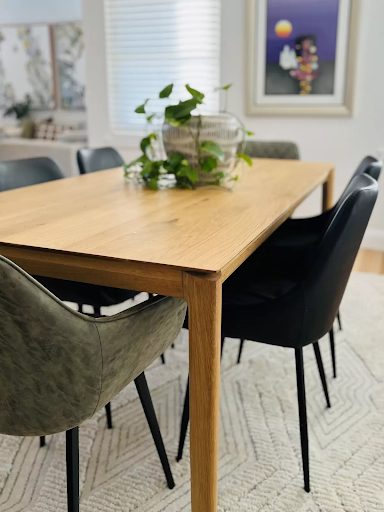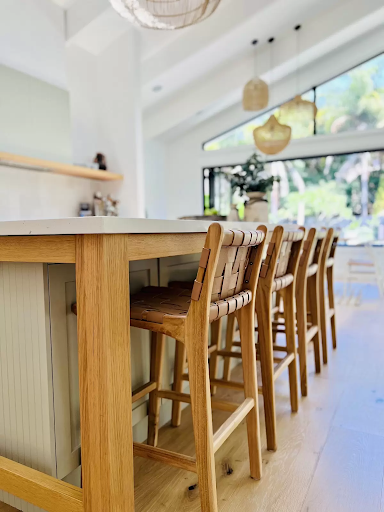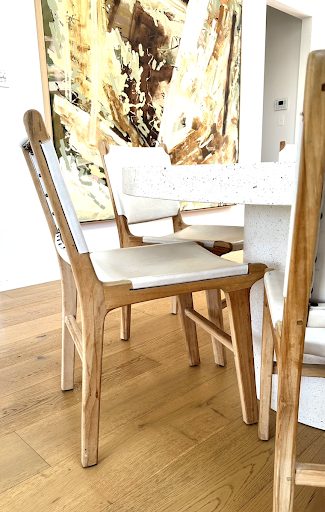Choosing Chairs? Selecting Stools?
Top Tips to Find the Right Ones for You
A recent reno – or even just update – on your kitchen or dining area can mean it’s time to get some new seating in place to match that stylish new look. Be that dining chairs, bar stools or both, I’ve got you covered.

Multi-Functioning in a Modern Home Interior
With the rise and rise of open-plan living there’s a lot less need these days for a separate dining room, or separate furniture to go within it. This means that today’s kitchen-diner seating has to be more multi-functional – and multi-stylish – than ever… covering occasions from breakfast to home-working to dinners with friends.
Harmonious Interiors

When designing an interior finishes scheme, all furniture within it should work in harmony. Consider the planned style of the space around your seating. Is there a particular era or aesthetic you’re going for? A contemporary look might involve complementing sleek lines alongside luxury finishes and textures whereas a more casual coastal scheme might employ natural timber, breezy ocean tones and textured organic finishes like rattan and linen for a more lived-in look.
Location
Where is your dining table to be located and have you ensured this is the best spot for it? If space is tight, opt for a smaller arrangement that won’t overwhelm the space and doesn’t restrict the general flow of traffic around the home. Think about putting the table against a wall if needs be or building in a dining bench if you feel the latter could be unavoidable. Before buying that huge table just for Christmas day gatherings, remember it’s best to furnish your house for everyday use rather than for the occasional event once or twice a year – an extendable table could be just the ticket, but they do come at a premium.


Timber seating
If you’re keen on wooden seating, the timber you choose will likely be influenced by your chosen scheme. Light timbers generally work best for Scandi and coastal looks, while darker timbers suit mid-century or heritage styles – though the chocolate tone of walnut works wonderfully in both moody and modern settings as well as the more classic styles. Beautiful rattan has also made a huge comeback in recent years, and evokes everything from upmarket Palm Springs, through vintage boho to colonial tropical vibes.
The Perfect Match
Think also about how your seating will work with the surface it will surround. What is the table or benchtop itself made of? Timber is the most popular dining table choice, in which case, either use the exact same material for your chairs or contrast definitively against it; something that’s ‘almost the same but not quite’ could easily look out of place. For example a black timber chair with an oak table is a great match; similarly an upholstered or leather dining chair will make a great complement. For any seating-surface combo, think about what you want the room’s focal point to be: are your chairs or stools the standout feature, or the stunning table or bartop? If the latter, your seats might just provide simple complement or contrast. Or, if you want them to do the talking, you might choose a more show-stopping design or colour.

Wow-factor
Wow-factor (if desired), along with your chosen scheme, will influence whether you employ colour, and how. If you do want your seating to pop, your chosen colour can make a bold statement in some way within the rest of your scheme (though for most aesthetics think complementary rather than clashing). Crisp whites and striking blues marry perfectly with the ever popular Hamptons look while rich block colours remain chic and contemporary in a minimalist setting. A pair of table end-chairs in a contrasting colour and style to the main collection of chairs can also make a great statement – and don’t forget to add a striking pendant light to finish the look.
For chairs to play a quieter role; focus on matching timber chairs and table or at least veer towards tonal differences of the same shade used elsewhere in the home; muted hues look great among traditional, coastal or Scandi schemes.

Inspiration
Before taking the plunge on this particular investment, be sure also to look beyond your home and take note of any seating that you feel works particularly well with the surrounding décor. While social media channels will yield endless images, getting amongst it can also help you appreciate the cohesion of a well curated scheme; aside from the obvious interiors stores; stylish eateries, bars, shops and salons can also be a great source of inspiration.



Wear and Tear
Consider the likely wear and tear for your chairs or stools, especially if you have young children or pets. If you do, any finish that’s super-sensitive to bumps or scratches, or any fabric difficult to remove or wash, is probably not for you. Yes, that includes the velvet-upholstered chairs you may have been eyeing up for some time (it’s a fact I struggle with myself – surely I can convince my cats not to destroy the chairs I so desperately crave?!) And as with any hard-working furniture, especially that which has to support a person’s weight, invest in the best quality you can afford and you’ll be rewarded with a solid item that gives you years of use.
Measure Twice, Buy Once

Please do your homework and take the time to get accurate measurements for your seats to avoid costly pitfalls. Standard dining-table height is between 71 and 76cm while the average chair seat is 47cm high.
Between the chair’s seat and the underside of the table top, or the table-rail if there is one (the wooden ‘pelmet’ that skirts around the sides of the table) you should be aiming for around 24-30cm, with 26cm being the ideal to allow enough space to manoeuvre in and out. You’ll also need to consider the space widthways around each chair, with most experts recommending about 15cm of elbow room between each – overall around 70cm per person is a comfortable seating width and will allow your chair to be pulled out without disturbing your neighbouring diner.
Remember also you will need to check the distance between the legs of the table to ensure that all chairs can be pushed under the table and that no one has to sit with an uncomfortable table leg between theirs. If your chairs have arms – be sure they will fit under the table and they are at a comfortable height for your guests. Finally allow around 70-90cm behind each chair to allow for easy pulling out and definitely no less than a metre between the table edge and the nearest wall or obstacle.
For bar stools and bar tops, although the overall heights will exceed those of tables or chairs, the important distance to consider is still that between your lap and the ‘leaf’ or surface top. For the average adult not to be slouching forwards if the stool is too high, or stretching up if it’s too low, you want to aim for around 23-28cm of space between lap and counter top. Again, around 15cm either side of each bar stool is recommended for wiggle room, though when measuring stools do take into account if they have arms, which will add extra width beyond just the seat.

Bar Stools – other considerations
A mix of practicality and preference… Do you want backrests? This could make them more comfortable to sit in for longer periods, like casual dinners. Having stools that swivel can also make them a bit more manoeuvrable, especially in tighter spaces, though they often cost more and can become pesky if you have young children who see them more as toys than furniture (and yes, I’m speaking from experience!) But whatever you do, ensure that any stool has, for comfort, a decently-placed foot rest for the average adult. Too high and it’s cramp-inducing but too low and numb, dangling legs can soon ruin relaxation.
And… Last of all
For any seating you choose, take a seat – literally, make sure you sit in it first! There’s nothing worse than an uncomfortable chair or stool, so always try before you buy. And if not – check the returns policy!
If you need any help furnishing your home please do reach out for a chat, we’d love to help!


